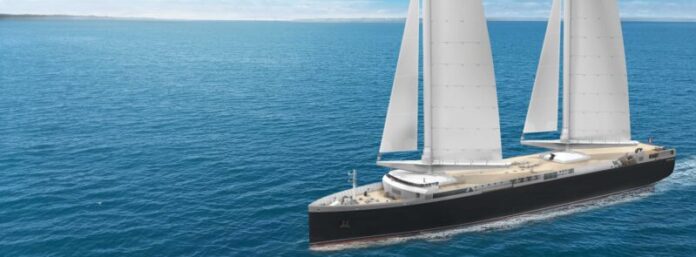
-
French transport giant CMA CGM says it has acquired a stake in Neoline to build the first Ro-Ro wind-propelled ship that will be launched in June 2025
-
The Neoline stake acquisition is in line with CMA CGM’s commitment to the United Nations’ Net Zero 2050 emission campaign
-
A liner shipping expert says Ro-Ro ships are the favorite among competing projects due to theirflexible operation, shallow drafts and smaller size suited for crowded ports
Vessels propelled by sails are likely to return to the seas in the near future as the global shipping industry looks for alternative energy to drive international trade and meet the United Nations’ goal of net zero carbon emission by 2050 for a sustainable environment.
That fossil-fuel-free future for cargo sea transport is just two and a half years away, barring unforeseen events that could scuttle a French shipyard’s work on a modern wind-powered ship.
France’s CMA CGM announced on January 18 its support for the construction of Neoliner, the first roll on, roll off (Ro-Ro) sailing ship to be built by the RMK Marine shipyard for Neoline that will be launched in June 2025 on transatlantic routes.
CMA CGM Fund for Energies will inject an unspecified amount of capital for a stake in Neoline, particularly to finance the construction of the 136-meter-long, 280-TEU Ro-Ro vessel Neoliner, which will have two 76-meter-high Solidsails folding carbon masts.
The company said the Neoline stake acquisition is in line with CMA CGM’s commitment to the United Nations’ Net Zero 2050 emission campaign.
“Thanks to its 3,000 square meters of sails, developed by Chantiers de L’Atlantique, this vessel will emit 80% to 90% less greenhouse gases than a traditional vessel of comparable size, and virtually no SOx and NOx particles,” CMA CGM said in a press release.
SOx (sulphur oxide) and NOx (nitrogen oxide) are emitted by ships and are blamed for damaging Earth’s ozone layer in the atmosphere, causing today’s global warming.
The acquisition of a stake in Neoline will enable the group to improve its knowledge of sail technology, a medium-term solution on the windiest routes, CMA CGM said.
RELATED READ: CMA CGM orders methanol-powered containerships
“The group, committed to be Net Zero by 2050, has been involved for years in the development of innovative projects and prototypes, to accelerate the decarbonization of the maritime sector,” said Emilie Espanet, head of CMA CGM Fund for Energies.
“We are convinced that several technologies will have to coexist to build the low-emission transport solutions of tomorrow. With the support of the CMA CGM Fund for Energies, Neoliner aims to be the first sailing cargo in operation as soon as 2025.”
Ship sailing is a medieval technology being explored by today’s shipping industry facing rising fuel costs and the vulnerability of oil and energy supplies to geopolitical situations, such as the war in Ukraine.
At the turn of the millennium, Hamburg-based SkySails was already experimenting with a fully automated towing kite propulsion system that would support the motors of cargo ships and large yachts, according to an article published by the cargo-partner.com portal.
The maiden voyage in 2008 of the environment-friendly prototype vessel allowed SkySails to test the kites extensively on a nearly 12,000-nautical-mile (22,240-km) route with satisfactory but not far-reaching results, the report said. The project, however, was put on ice at the approach of global economic crisis and the consequent drop in fuel prices.
European aircraft maker Airbus also plans to use wind power on its own cargo ship fleet with stunt kites. Its subsidiary AirSeas has developed a wind propulsion system for four freighters that Airbus operates to carry aircraft parts to plants in Mobile, Arizona, and in Tianjin, China.
Liner shipping expert Jerome de Ricqles, in an analysis published by upply.com, said the energy crisis is generating increased interest in what seemed at first to be just a romantic dream, carbon-emission-free vessels, like the Neoline sail ship project.
“International shipping represents only 2.5% of global greenhouse gas emissions. The sector must, nevertheless, play its part in the efforts under way to fight against global warming and, therefore, start decarbonizing,” de Ricqles said.
De Ricqles said Ro-Ro ships seem to be the favorite among competing projects due to their flexible operation, uncluttered decks, shallow drafts and smaller size, allowing optimized quayside operations in crowded ports.
He said Neoline is among the most advanced, sail-powered cargo ship projects that CMA CGM champions. Set up in 2015, Neoline aims to launch a new regular transatlantic line between Saint-Nazaire in France and the Canadian and US ports of Halifax and Baltimore, with calls in the French territory of St-Pierre-et-Miquelon. He said the line will be served by two ships 280-TEU Neoliner ships making two sailings each month.
The analyst said part of the Neoline sail ship project deal, which CMA CGM announced initially in September 2022, provides fresh support for the French merchant navy officer and ratings training program, which serves the interests of the wider CMA CGM fleet.




